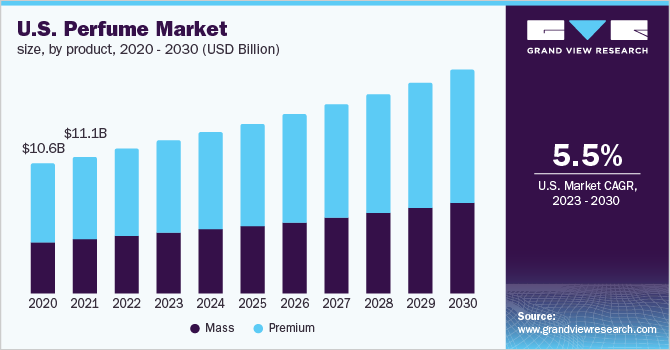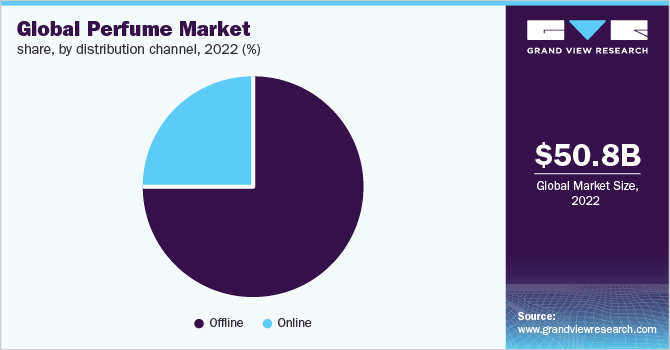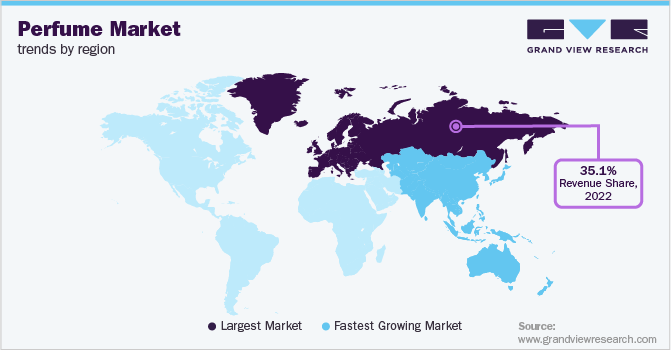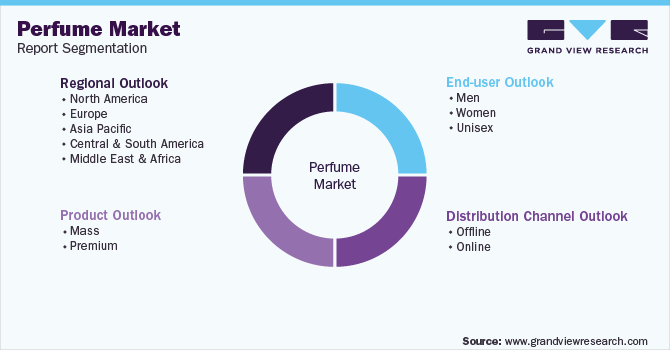
Perfume Market Size, Share & Trends Analysis Report By Product (Mass, Premium), By End-user (Men, Women), By Distribution Channel (Offline, Online), By Region (Europe, APAC), And Segment Forecasts, 2023 - 2030
- Report ID: GVR-2-68038-906-7
- Number of Report Pages: 82
- Format: PDF
- Historical Range: 2011 - 2021
- Forecast Period: 2023 - 2030
- Industry: Consumer Goods
Report Overview
The global perfume market size was valued at USD 50.85 billion in 2022 and is expected to register a compound annual growth rate (CAGR) of 5.9% from 2023 to 2030. The market growth is attributed to the growing trend of personal grooming, coupled with increasing demand for luxury and exotic fragrances. Moreover, increasing consumer spending on premium and luxury fragrances due to the high-income level, along with improving living standards, is driving the global industry. In recent years, perfumes have evolved into a significant business in the cosmetics and personal care industry. Perfumes have emerged as an essential product driven by the growing trend of personal care, forming a part of pride and confidence.

However, the adverse effects of synthetic chemicals used in perfumes could restrain product adoption and are projected to hamper growth during the forecast period. In addition, the growing demand for natural ingredients-based perfume products across the globe is projected to provide significant opportunities for industry growth. Moreover, the growing trend for using customized fragrances is further expected to boost industry growth. For instance, WAFT Perfume, Inc. offers custom fragrances for personal use as well as for gifting purposes. The COVID-19 pandemic negatively impacted the global industry as the sales of industry players declined during the COVID-19 outbreak.
For instance, LVMH Group, one of the major manufacturers of perfume products, experienced around a 20% decline in perfume revenue in 2020 as compared to 2019. The decrease in revenue was mainly due to the government restrictions on the opening of beauty salons, perfumeries, and department stores and stay-at-home orders as a precautionary measure during the outbreak. However, the global market is recovering owing to the resumed manufacturing process, trade, and sales, which is anticipated to result in significant growth. In addition, product diversification by manufacturers is expected to expand the customer base. For instance, CHANEL offers a diverse range of perfume products including Eau de parfum spray, parfum, and others under its fragrance portfolio.
Product innovations based on customer needs are further augmenting sales in the market. For instance, Lauder’s Jo Malone stores offer fragrance consultations so that shoppers can develop customized products. Moreover, the Tokyo location of this brand had an artist placed near checkout to outline cityscapes on packaged boxes to create a unique product packaging design. Furthermore, the company purchased the artisan perfume house By Kilian, thereby adding to its store trendy names, such as Le Labo and Editions de Parfums Frederic Malle. They offer in-store blending on customer demand with an aim to provide a premium shopping experience of handcrafted products.
The changing fashion trends also have a primary influence on the global market and key manufacturers operating are focusing on developing and launching fragrances that are unique and attract diverse consumer bases across the globe. In addition, light-scented fragrances are also gaining attraction among the millennial and Gen Z population, encouraging manufacturers to develop such products. Furthermore, the increasing focus of manufacturers to introduce natural fragrances in the premium category owing to the rising concerns regarding allergies caused by synthetic ingredients in perfumes is another significant factor driving the industry growth. For instance, ST. ROSE, STRANGE INVISIBLE PERFUMES, and Lavanila are some of the brands that offer natural premium fragrances.
Celebrity endorsements and social media influencers have a growing influence among consumers that affect their buying decisions due to which, it is one of the trending advertisement strategies among key manufacturers. Companies are actively opting for and investing in such strategies along with investing in technology to attract consumers and widen their reach. For instance, L'Oréal Groupe developed a tool named dubbed cockpit, designed to measure the real-time ROI and productivity level of its media investments. This technology enabled better decision-making while formulating performance strategies. These factors have been aiding companies to understand their product performance and develop products to meet customer needs, thereby contributing to the growth of the global industry.
Product Insights
Based on products, the global industry is further classified into mass and premium. The premium segment contributed to the largest revenue share of over 55% in 2022. The growth has surpassed that of mass fragrance products in the last few years owing to a greater emphasis on quality, personalization, and exclusivity. Manufacturers are also focusing on widening their offerings to include high-end products. For instance, Coty Inc. has slimmed down its product portfolio of low-priced labels after the acquisition of some of Procter & Gamble’s beauty brands. Since then, it has been focusing on luxury lines, which include Gucci Bloom and Tiffany & Co., targeting millennials.
The mass segment is estimated to register the fastest CAGR during the forecast period. The segment is growing mainly due to the rising demand for mass perfume products in emerging economies, such as India, China, and others. Mass perfumes are more cost-effective and are available in various types, such as body mists, body splashes, cologne body sprays, and others, to cater to the varying needs of consumers. Therefore, the cost-effectiveness of the mass perfumes further encourages demand among the middle-income population that further contributing to the segment growth.
End-user Insights
The women end-user segment accounted for the largest share of more than 62.85% in 2022. It is observed that women in the U.S. purchase a new perfume as often as once a month, in comparison to men who buy it on an average of 1-2 times per year. As per a survey, around 41% of the females in the U.S. use perfumes every day as compared to men. In the U.K., women pay more for fragrances than men, wherein female perfumes cost an average of about 6p more per ml compared to male fragrances of the same brands. Perfume sales are expected to rise among women irrespective of its high price points, as they consider it to be an essential part of personal care.
The men end-user segment is estimated to register the fastest growth rate during the forecast period. The growing trend of using fragrance products among men across the globe is one of the major factors that drive industry growth. Moreover, the growing demand for trendy perfumes, different flavors, and premium fragrance products among men is projected to support the segment growth during the forecast period. The substantial brand endorsement of celebrities further encourages the men population to purchase personal care products, such as perfumes. This is also anticipated to provide noteworthy growth opportunities to the segment.
Distribution Channel Insights
On the basis of distribution channels, the industry has been categorized into offline and online. The offline segment accounted for the largest share of more than 74.65% in 2022. Consumers prefer this channel to purchase their products due to the availability of a wide range of options as well as the facility of scanning the product details before any purchase. The offline segment is also driven by sales from specialty stores that offer premium products. The layout of the supermarket and promotional campaigns by leading brands have also increased the sales volume through these channels. Moreover, the growth of the organized retail sectors has been driving the segment by providing ample space and visibility for the existing brands to offer their products.

However, the online distribution channel segment is expected to expand at the fastest CAGR from 2023 to 2030. The evolution of online retail channels, such as Flaconi, Amazon, and Parfumdreams, has turned out to be a new and convenient way of distributing perfumes, despite consumers not being able to test the fragrance before purchase. Various modes of advertisement and promotional strategies are adopted by players to offer their products through the online channel. The other factor that drives the segment growth includes the increasing e-commerce industry in emerging economies. In China, India, and other emerging economies, online channels are gaining traction for fragrance product browsing and shopping, which is projected to propel the segment growth during the forecast period.
Regional Insights
Europe accounted for the largest revenue share of more than 35.10% in 2022. Major countries contributing to the regional growth include Germany, France, and the U.K. In 2020, Coty Inc. was positioned as the leading player in the perfume industry in Germany. The growth was attributed to the strong sales of premium products through brands, such as Jil Sander and Calvin Klein, along with new product launches from other brands, such as Hugo Boss. France is home to numerous leading fragrance brands, such as Christian Dior, Chanel, and Guerlain. The country has been driving the Europe market with the highest production and export values. Asia Pacific is expected to emerge as the fastest-growing region over the forecast period.

The changing beauty trends in the Asia Pacific region are resulting in an increasing demand for luxury and premium fragrances, which is also encouraging manufacturers to set their footprints in this region, thus driving its growth. Moreover, the popularity of travel-size, mini, and pocket-size perfumes is growing as they can be used on the go and are convenient, which is expected to fuel the market growth. For instance, In October 2021, Kanelle launched its first line of fragrances named ‘Scentsationally You’. This includes five scents that come in various ranges of product options and sizes. Along with that, the significant growth in the personal care industry in emerging countries, such as China and India, further supports the region’s growth.
Key Companies & Market Share Insights
Major companies are developing products aiming to provide fragrances that adapt easily to consumers’ skin pH levels, thereby spurring the growth of the global market. Some of the initiatives taken by players operating in the industry include:
-
In September 2022, Givaudan announced its collaboration with LanzaTech to develop fragrance ingredients that are sustainable using renewable carbon
-
In September 2021, Coty Inc. announced the partnership agreement with Perfect Corp. for the integration of a suite of AI and AR practices into the digital marketing toolkits of its cosmetics brands
-
In October 2020, Coty Inc. announced the launch of a new fragrance ‘Perfect Marc Jacobs’ for women under its division Marc Jacobs International and Marc Jacobs Fragrances
Some of the prominent players in the global perfume market include:
-
The Avon Company
-
CHANEL
-
Coty Inc.
-
LVMH Moet Hennessy-Louis Vuitton
-
The Estée Lauder Companies
-
Revlon
-
Puig
-
L'Oréal Groupe
-
Shiseido Company, Ltd.
-
Givaudan
-
Hermès
- KERING
Perfume Market Report Scope
|
Report Attribute |
Details |
|
Market size value in 2023 |
USD 53.70 billion |
|
Revenue forecast in 2030 |
USD 80.16 billion |
|
Growth rate |
CAGR of 5.9% from 2023 to 2030 |
|
Base year for estimation |
2022 |
|
Historical data |
2017 - 2021 |
|
Forecast period |
2023 - 2030 |
|
Quantitative units |
Revenue in USD million/billion and CAGR from 2023 to 2030 |
|
Report coverage |
Revenue forecast, company ranking, competitive landscape, growth factors, and trends |
|
Segments covered |
Product, end-user, distribution channel, region |
|
Regional scope |
North America; Europe; Asia Pacific; Brazil; Middle East & Africa |
|
Country scope |
U.S.; Canada; Mexico; U.K.; Germany; France; Italy; Spain; China; India; Japan; South Korea; Singapore; UAE; Brazil |
|
Key companies profiled |
The Avon Company; CHANEL; Coty Inc.; LVMH Moet Hennessy-Louis Vuitton; Estée Lauder Companies; Revlon; Puig; Shiseido Company, Limited; Givaudan; Hermès; KERING |
|
Customization scope |
Free report customization (equivalent up to 8 analysts’ working days) with purchase. Addition or alteration to country, regional & segment scope |
|
Pricing and purchase options |
Avail customized purchase options to meet your exact research needs. Explore purchase options |
Global Perfume Market Segmentation
This report forecasts growth at global, regional, and country levels and provides an analysis of the latest industry trends in each of the sub-segments from 2017 to 2030. For the purpose of this study, Grand View Research has segmented the global perfume market report on the basis of product, end-user, distribution channel, and region:

-
Product Outlook (Revenue, USD Million, 2017 - 2030)
-
Mass
-
Premium
-
-
End-user Outlook (Revenue, USD Million, 2017 - 2030)
-
Men
-
Women
-
Unisex
-
-
Distribution Channel Outlook (Revenue, USD Million, 2017 - 2030)
-
Offline
-
Online
-
-
Regional Outlook (Revenue, USD Million, 2017 - 2030)
-
North America
-
U.S.
-
Canada
-
Mexico
-
-
Europe
-
U.K.
-
Germany
-
France
-
Italy
-
Spain
-
-
Asia Pacific
-
China
-
India
-
Japan
-
South Korea
-
Singapore
-
-
Central & South America
-
Brazil
-
-
Middle East & Africa
-
UAE
-
-
Frequently Asked Questions About This Report
b. The global perfume market size was estimated at USD 50.85 billion in 2022 and is expected to reach USD 53.70 billion in 2023.
b. The global perfume market is expected to witness a compound annual growth rate of 5.9% from 2023 to 2030 to reach USD 80.16 billion by 2030.
b. Women accounted for the largest share of 62.9% in 2022. It is observed that women in the U.S. purchase a new perfume as often as once a month, in comparison to men who buy it on an average of 1-2 times per year, mainly for the purpose of replenishment.
b. Some key players operating in the perfume market include The Avon Company; CHANEL; Coty Inc.; LVMH Moet Hennessy - Louis Vuitton; L’Oreal Groupe; Estée Lauder Inc; Revlon; and Puig.
b. Key factors such as the growing trend of personal grooming, coupled with increasing demand for luxury and exotic fragrances are expected to drive the market growth over the forecast period.
We are committed towards customer satisfaction, and quality service.
"The quality of research they have done for us has been excellent."




